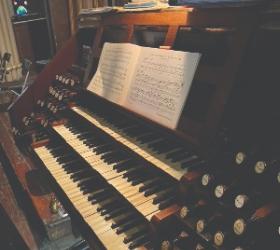
Parkey OrganBuilders,
Duluth, Georgia, Opus 10
Holy Trinity Lutheran Church,
Marietta, Georgia
Holy Trinity Lutheran Church made the commitment to a pipe organ in the late 1970s as part of the construction of their new sanctuary. Though a new pipe organ was not in the plan, the church purchased a Votteler-Holtkamp-Sparling organ from First & Calvary Presbyterian Church in Springfield, Missouri. A dedicated group of members aided by a consultant/organbuilder moved the organ to Marietta, Georgia, and completed the installation of the organ in late 1980.
By 1980, the organ had been moved, altered, and enlarged. During the mid-1990s, Tim Young, the current organist, took the job as parish musician and began to evaluate the instrument and bring it into line with the needs of the church’s music program. Over time it was realized that the organ was far too large in sound to balance the room, and, unfortunately, some of the additions had not been as successful as originally hoped.
We were invited to look at the organ in 1997 and make a proposal to replace the console and relay switching system. In 2000, our firm completed a new three-manual drawknob console complete with new relays and capture system by Solid State Logic (now Solid State Organ Systems). This vastly improved the control of the organ, and the movable console allowed some changes of the choir space and chancel area.
In 2004, we made a number of changes, with new pipework to improve the diapason/principal choruses for a better balance in the room. Part of our tonal work included the addition of mutations to the Choir division in place of some of the redundant 8′ stops added in the 1950s by the Kilgen Organ Company. The changes worked very well and were well received by the membership.
By 2005, the church was discussing a major renovation of the sanctuary. The organ was showing its age in the mechanical/windchest department. Due to immediate need, chestwork was constructed and installed in the Great division in 2006. The church council later voted to include the pipe organ in the sanctuary renovation.
The sanctuary renovation was the impetus to remove the entire organ and recreate it as one cohesive instrument. By 2007, working with Tim Young, we completed the details of an ongoing tonal revision and layout of the organ, and a contract was signed in early 2008.
The organ was removed in summer 2008. Work began with new windchests and winding systems. The new organ features electro-pneumatic slider chests of our design and construction. The winding system is provided by single-rise box regulators. Chamber layouts were changed for improved tonal design and egress and to accommodate the relocation of the choir in the chancel. A new case and façade were designed in conjunction with Frank Friemel and added to the organ to replace the grille cloth and curtains of 1980. The case contains the bass of the 8′ Principal and 16′ Violone. It is built of clear red oak and finished to coordinate with the church’s interior finishes and woodwork. Acoustical improvements were made to the worship space to enhance the congregational singing and tonal presence of the organ and other instruments.
From the first we had planned for tonal changes to fill voids in the specification and create a better balance for congregational singing and choral accompaniment. The Clarinet and Oboe stops were retained from the 1929 Holtkamp organ, as were some of the flutes and strings. One rank of interest is the 8′ Ludwigtone from the 1929 Holtkamp; it was retained in the Choir division. The principal ranks are new, providing three complete principal choruses—one in each manual division. New trumpet ranks were added to the Swell, Great and Pedal divisions.
The Great division features a principal chorus of American heritage found in organs of the mid to late 1800s. The Swell division is based on an American Classic design that became prevalent in the 1930s. The Swell division starts with the backbone of an 8′ Violin Diapason and builds through to mixture. The strings and flutes retained in the Swell division promote a bit of romantic flair not lost in the history of the organ. The Choir division features many nuances of an English Choir division, again hosting its own diapason chorus through to mixture. The Choir principal (called Geigen) displays a lighter, articulate tone, useful for choral work. The 4′ Fugara is a string principal, adding a singing quality to the division while providing good blend with the Geigen.
The principal choruses combine to provide a solid foundation for congregational singing much as found in the Silbermann organs of the 1700s. Our flutes throughout the organ offer a wide variety of color, utilizing both open and closed variations in wood and metal. The reeds provide both color for solo work and fire for the final cap of the ensemble.
Tim Young worked closely with us during the reinstallation and tonal finishing of the instrument. The physical installation was completed in December 2008, and the final tonal work was completed in early 2009. Matthew Brown of Salisbury, North Carolina, a student of Gillian Weir, was a featured recitalist in April 2009. He demonstrated the flexibility of the organ through the works of Sweelinck, Bach, Harris, Vierne, Demessieux, and Calvin Hampton.
Our appreciation goes to Tim Young, organist; Ann Murphy, music director; and Ralph Daniel, charter organ committee member, for their help and cooperation on our Opus 10.
—Phil Parkey
GREAT
16′ Sub Principal 29 pipes
(1-32 from Pedal Violone)
8′ Principal 61 pipes
8′ Bourdon 61 pipes
4′ Octave 61 pipes
4′ Spitzflote 61 pipes
2′ Super Octave 61 pipes
III Fourniture 183 pipes
8′ Trumpet 61 pipes
4′ Clarion 12 pipes
Chimes
Zimbelstern
Great 16–Unison Off–4
SWELL
16′ Lieblich Gedeckt 61 pipes
8′ Violin Diapason 61 pipes
8′ Stopped Diapason 61 pipes
8′ Salicional 61 pipes
8′ Voix Celeste 61 pipes
4′ Principal 61 pipes
4′ Flute Harmonic 61 pipes
2′ Flute 61 pipes
III Plein Jeu 183 pipes
16′ Basson 12 pipes
8′ Trompette 61 pipes
8′ Oboe 61 pipes
4′ Oboe Clarion 12 pipes
Tremulant
Swell 16–Unison Off–4
CHOIR
8′ Geigen 61 pipes
8′ Flute 61 pipes
8′ Ludwigtone 61 pipes
8′ Dulciana 61 pipes
8′ Unda Maris TC 49 pipes
4′ Fugara 61 pipes
4′ Chimney Flute 61 pipes
22⁄3′ Nazard 61 pipes
2′ Flautino 24 pipes
13⁄5′ Tierce 61 pipes
III Mixture 183 pipes
8′ Clarinet 61 pipes
8′ Trumpet Gt
Tremulant
Choir 16–Unison Off–4
PEDAL
32′ Contra Bourdon 32 notes
16′ Diapason 32 notes
16′ Subbass 32 pipes
16′ Violone 32 pipes
16′ Lieblich Gedeckt Sw
8′ Octave 32 pipes
8′ Flute 12 pipes
8′ Gedeckt Sw
4′ Choral Bass 32 pipes
4′ Open Flute 32 notes
III Mixture 32 notes
16′ Bombarde 32 pipes
8′ Trumpet 12 pipes
Couplers
Great to Pedal 8, 4
Swell to Pedal 8, 4
Choir to Pedal 8, 4
MIDI to Pedal
Swell to Great 16, 8, 4
Choir to Great 16, 8, 4
MIDI to Great
Swell to Choir 16, 8, 4
MIDI to Choir
Choir to Swell 8
Choir/Great Transfer




